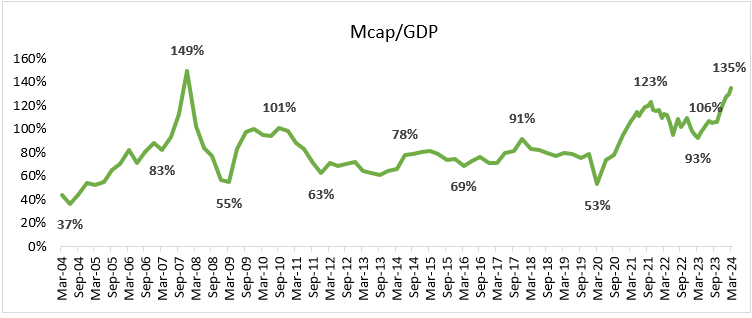We thought we will discuss our investment process through the example of the asset management companies (AMCs) that we have held for over 5 years in our portfolio. Why did we buy the AMCs? First, they have a very high rate of profitability as represented by their core Return on Equity (ROE) adjusted for cash on the balance sheet, which is actually infinite in a few cases because cash on balance sheet is more than the networth. Second, they have a large opportunity in terms of the increasing preference for equity among the saving community, more in line with international norms than it has been in the past.
An asset management company which can retain assets and grow them over time, can have a perpetually growing franchise. The underlying asset the mutual fund invests in, is growing over time at a healthy rate, and then there are inflows from existing clients and new clients. These levers make AMCs kind of perpetual growth machines. Long term performance of the different schemes of the AMCs, of course, play a vital role in success in this business. Also important is the brand in the eyes of the customer and distribution strength. The business requires virtually no working capital. AMCs deduct their fees from their various schemes on a daily basis. So, no receivables, no inventory and your employee expenses don’t grow at the rate at which your assets are growing. Hence, there is tremendous operating leverage.
There is however a small negative – AMCs are dependent on distributors who command their pound of flesh in terms of the share of the customer pie AMCs have to share with them. Historically mutual funds have been a ‘push’ product with the distributor playing a significant role in the decision- making process for the investor. However, asset management companies which have a good brand and good long-term performance can ensure that the revenue pie is equitably split between the AMC and the distributor.
In September 2018, SEBI came out with a regulation which asked AMCs to reduce the Total Expense Ratio (TER) sharply as the size of their mutual fund schemes increase in size. This caused revenue yields for AMCs to compress and this resulted in relatively poorer revenue and earnings growth for the AMCs for a few years. We also wrote about this in our October 2022 newsletter where we said that despite these near-term issues, the valuations look attractive. Valuations of a high-quality stock are usually attractive (low) when there is some near-term issue or uncertainty that the company or sector is facing. At the time, there were also fears of SEBI coming down hard on AMCs again but some of the worst fears did not eventually materialise. In FY2024 the AMCs have benefited from the large rise in equities in general as also robust inflows into equity schemes. As a result, operating leverage has kicked in for the AMCs and they have reported strong profit growth for the year ended 31-Mar-2024.
Back in October 2022, the AMCs were trading at low valuations with respect to their history. Valuations are now higher and closer to the top end of their valuation zones. This has given us an opportunity to trim some of our holdings in the AMCs as per our process of reducing weights when the market is more cheerful. This process of a stock moving from the lower end of the valuation zone to the higher end of the valuation zone takes several years, as we have seen with our AMC holdings. We hope to continue with our discipline with respect to our investment process in the future as well.


